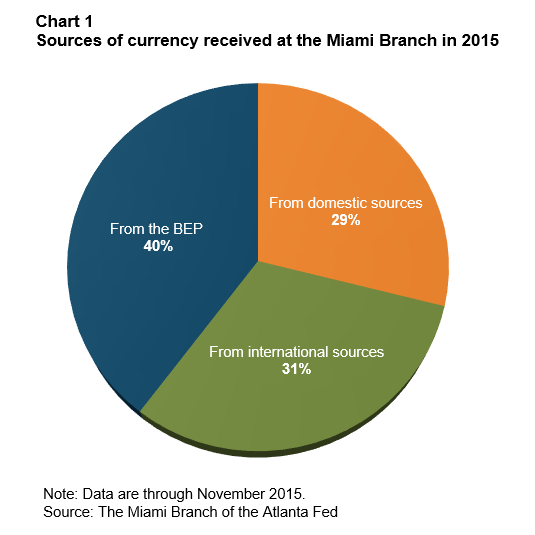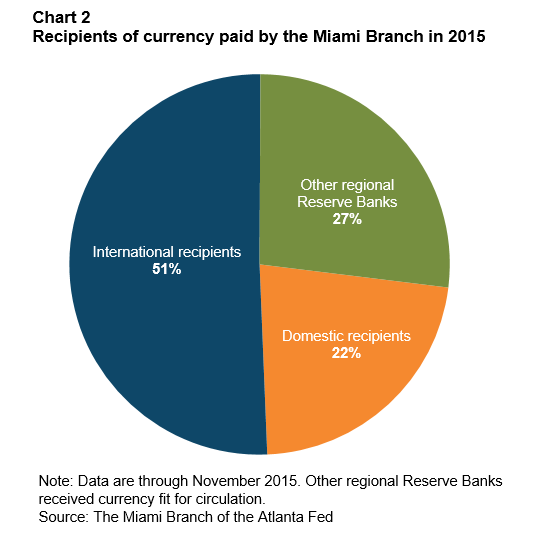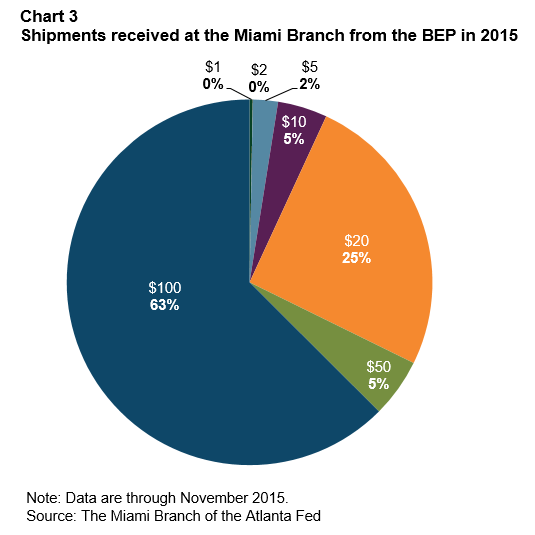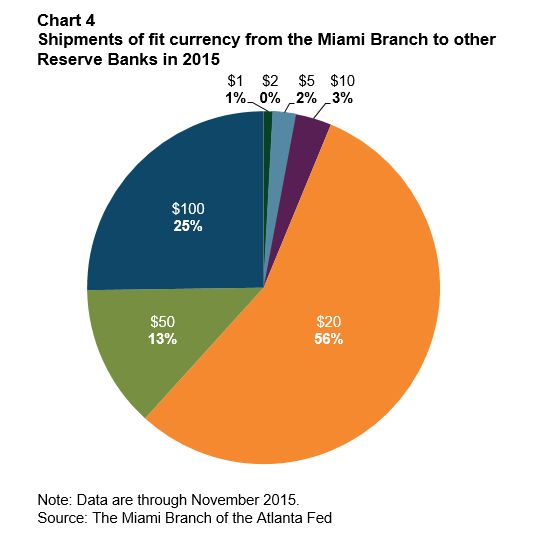
When most people think of South Florida, they think of sun and fun, not currency. But South Florida's proximity to the Caribbean Basin and Central and South America has been a key factor in the development of the Miami Branch's strategic role in U.S. currency distribution. The Miami office, along with 27 other Reserve Bank sites, distributes currency and coin under the authority of the Federal Reserve Board of Governors; however, Miami is unique in that its geographic proximity to Latin America and the Caribbean region makes it a hub for banks that service these markets.
The Miami Branch's Cash Department provides currency and coin to financial institutions (FIs) in the 13 southernmost counties in Florida and accepts excess cash as deposits from these customers to match market demand. This domestic activity accounted for roughly 24 percent of the value of all transactions processed by the branch during the last year. Exchanges with correspondent banks and foreign central banks, which provide U.S. currency services to clients in foreign countries, make up another part of the branch's work. Most of these global cash transactions involve end users in Central and South America and the Caribbean Basin. Paul Graham, vice president and branch manager at the Miami Branch, noted that "only a small number of Federal Reserve cash sites are designated by customers as a preferred site to supply U.S. currency on a global level." In Miami's case, this preferred designation is driven by logistics and ease of transport given the city's location and its air, rail, and port infrastructure.
Another aspect of Miami's cash activity consists of receiving new currency shipments from the Bureau of Engraving and Printing (BEP) and providing "fit" currency to Federal Reserve locations for recirculation throughout the United States. Both of these activities in the Miami Branch are significantly higher relative to other Federal Reserve branches because of its role in international currency distribution.
Miami Branch fulfills payouts around the globe
International payouts accounted for 69 percent of the dollar value of customer orders filled by the Miami Branch in 2015. Similarly, 52 percent of the dollar value of 2015 currency deposits to Miami from FIs originated abroad. The frequency of nonstop commercial flights between Miami and Latin American and Caribbean destinations makes transactions with the Miami Branch an attractive, low-cost solution for international customers to meet U.S. dollar demand.
Currency deposits from international FIs remained strong in 2015, accounting for a third of all currency received at the Miami facility. Notes repatriated from the three dollarized economies of Panama, Ecuador, and El Salvador together made up more than 30 percent of all domestic and international deposits to Miami in 2015.
Hot off the presses: First stop—Miami, for Benjamins and Jacksons
In 2015, 24 percent of currency notes received by the Miami Branch from all sources came in the form of newly printed banknotes from the Bureau of Engraving and Printing (see chart 1). Although new currency from the BEP is also distributed to domestic institutions, the primary demand for new, uncirculated banknotes originates overseas (see chart 2). The international market demands new currency notes because of concerns about high-quality counterfeits produced abroad. Consistent with Federal Reserve System policy, all cash orders paid to foreign countries are filled with new U.S. currency, requiring Miami to maintain relatively high inventories of new currency to ensure prompt filling of international orders. The status of the U.S. dollar as a global currency and the provision of newly printed notes to the foreign market also benefit the U.S. Treasury, which receives seigniorage income from all U.S. banknotes released into circulation. (Seigniorage, a common revenue source for central banks, is the difference between the interest earned on securities obtained in exchange for bank notes and the expense associated with producing and distributing those notes.)


The $100 and $20 denominations account for the majority of the new currency shipped to the Miami Branch, and this currency in turn is shipped to financial institutions abroad (see chart 3). The $100 note is much more commonly used outside the United States and makes up the bulk of international shipments. For this reason, the Miami Branch stockpiled inventory of the redesigned $100 note well in advance of its release to financial institutions in October 2013, in anticipation of heightened international demand. The second-largest share of new currency shipped to Miami in terms of value is made up of the $20 note, which is used extensively in the dollarized countries for transactional purposes.

Miami cash as a fulfillment center for the Fed
The sorting and authentication process conducted on incoming deposits by all Federal Reserve cash operations sites results in "fit" currency, or currency that can be recirculated to fulfill domestic cash orders, and the Miami Branch generates fit currency exceeding local demand (see chart 4). The volume of fit currency produced by each site depends on the denomination, volume, and quality characteristics (soil levels, for example) of currency deposited at that location. In many cases, fit currency generated by a Federal Reserve site results in minimal to no surplus. Alternatively, a high volume of notes received in good condition means a site produces more fit currency, creating an excess stock of notes payable to circulation. The Fed's Board of Governors coordinates shipments of fit currency among the different Reserve Banks to use excess fit inventory that accumulates in offices such as Miami to meet currency needs in other Reserve Bank areas.

In Miami, paying out new currency to international customers results in a higher-quality note being returned in deposits, especially for higher denominations. It also means that the volume of fit currency being generated from international customer deposits is high. As a result, Miami has produced approximately 32 percent of all fit shipments distributed within the Federal Reserve System in 2015. These fit shipments are transported to Federal Reserve cities across the country to help fill domestic demand. The large number of fit shipments, coupled with robust payments to international financial institutions, means that currency payouts to domestic FIs accounted for only 22 percent of the value of currency shipped by Miami to all sources in 2015. Graham noted that "the size and scope of our cash operation is heavily influenced by the needs of our customers servicing international markets."



